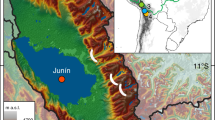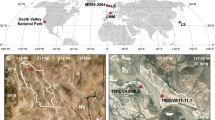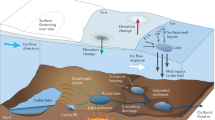Abstract
IT is commonly thought that the climate conditions that supported lakes over a period of years in the Mojave Desert in southern California, only existed before 8,000 yr BP and that the environment has been arid since1,2. Here we look at a drill core in the Silver Lake playa at the terminus of the Mojave River and find Holocene lake deposits which indicate that shallow lakes existed for at least a few decades. These deposits were radiocarbon dated at 3620 ±70 and 390 ± 90 yr BP, corresponding to the early Neo-glacial and the 'little ice age' respectively3. To identify the conditions necessary to produce these Holocene lake events we have examined the modern climate and hydrological patterns that produce ephemeral lakes in this usually arid watershed. Available data indicate that there is a link between anomalous winter atmospheric conditions over the North Pacific and Mojave River floods that produced ephemeral lakes in the Silver Lake playa and that the Mojave River filters out small to medium floods and allows only the extreme floods to reach the terminal playa and leave a record of the anomalous conditions. We suggest that the late Holocene lakes may have resulted from persistent similar atmospheric circulation patterns and winter floods.
This is a preview of subscription content, access via your institution
Access options
Subscribe to this journal
Receive 51 print issues and online access
$199.00 per year
only $3.90 per issue
Buy this article
- Purchase on Springer Link
- Instant access to full article PDF
Prices may be subject to local taxes which are calculated during checkout
Similar content being viewed by others
References
Smith, G. I. & Street-Perrott, F. A. in The Late Pleistocene (ed. Porter, S. C.) 190–212 (University of Minnesota Press, 1983).
Van Devender, T. R. et al. in The Geology of North America vol. K-3 (eds Ruddiman, W. F. & Wright, H. E.) 323–357 (Geological Society of America, Boulder, 1987).
Wells, S. G. et al., Rep. 249 (New Mexico Water Resources Research Institute, Las Cruces, 1989).
Thompson, G. D. Water Supply Paper 578 (United States Geological Survey, Washington, DC, 1929).
Ore, H. T. & Warren, C. N. Geol. Soc. Am. Bull. 82, 2553–2562 (1971).
Wells, S. G. et al. Quat. Res. 27, 130–146 (1987).
Blaney, F. H. Am. geophys. Un. Trans. 38, 209–215 (1957).
Troxel, H. C. & Hofman, W. in Geology of Southern California (ed. Jahns, R. H.) Bull. 170 Ch. 5, 13–17 (California Division of Mines, San Francisco, 1954).
Buono, A. & Lang, D. J. Open File Rep. 80–207 (United States Geological Survey, Menlo Park, 1980).
United States Geological Survey, WATSTORE Peak Flow Files (United States Geological Survey, 1987).
Wells, S. G. et al. Eos 68, 1270 (1987).
National Climatic Center, Hourly Precipitation Data vol. California (United States Department of Commerce, National Atmospheric and Oceanographic Administration, Asheville.
Weather Bureau, Hydrometeorological Report 37 (United States Department of Commerce, Weather Bureau, Washington, DC, 1962).
Trenberth, K. E. & Paolino, D. A. Mon. Weath. Rev. 108, 855–872 (1980).
Namias, J. CalCOFI Atlas No. 22 (Scripps Institution of Oceanography, La Jolla, 1975).
Klein, W. H. & Bloom, H. J. Mon. Weath. Rev. 115, 2118–2132 (1987).
Namias, J. Proc. 5th Annual Clim. Diagnostics, Workshop 35–50 (United States Department of Commerce, National Atmospheric and Oceanographic Administration, Asheville, 1980).
Cayan, R. D. & Peterson, D. H. in Aspects of Climate Variability in the Pacific and Western Americas (ed. Peterson, D. H.) (American Geophysical Union, in the press).
Wagner, J. A. Mon. Weath. Rev. 97, 351–358 (1969).
Bonner, W. et al. Rep. E-3270(N) (Department of Meteorology, University of California, Los Angeles, 1971).
Namias, J. et al., J. Clim. 1, 682–703 (1988).
Michaelsen, J. & Haston, L. Final Rep.—Water Resources Center Project W-707 (Department of Geography, University of California, Santa Barbara, 1988).
Schulman, E. Bull. (Laboratory of Tree-Ring Research, University of Arizona, Tucson, 1947).
Fritts, H. C., Lofgren, G. R. & Gordon, G. A. Quat. Res. 12, 18–46 (1979).
LaMarche, V. C. Science 183, 1043–1048 (1974).
Author information
Authors and Affiliations
Rights and permissions
About this article
Cite this article
Enzel, Y., Cayan, D., Anderson, R. et al. Atmospheric circulation during Holocene lake stands in the Mojave Desert: evidence of regional climate change. Nature 341, 44–47 (1989). https://doi.org/10.1038/341044a0
Received:
Accepted:
Issue Date:
DOI: https://doi.org/10.1038/341044a0
This article is cited by
-
In Memoriam: Roger Yates Anderson (1927–2021)
Journal of Paleolimnology (2022)
-
Construction, maintenance and abandonment of hydraulic systems: hydroclimatic or social constraints? A case study of prehistoric Hohokam irrigation systems (Phoenix, Arizona, USA)
Water History (2015)
-
Extended megadroughts in the southwestern United States during Pleistocene interglacials
Nature (2011)
-
Peat Accretion Histories During the Past 6,000 Years in Marshes of the Sacramento–San Joaquin Delta, CA, USA
Estuaries and Coasts (2009)
-
Taphofacies analysis of recent shelly cheniers (beach ridges), northeastern baja california, Mexico
Facies (1994)
Comments
By submitting a comment you agree to abide by our Terms and Community Guidelines. If you find something abusive or that does not comply with our terms or guidelines please flag it as inappropriate.



